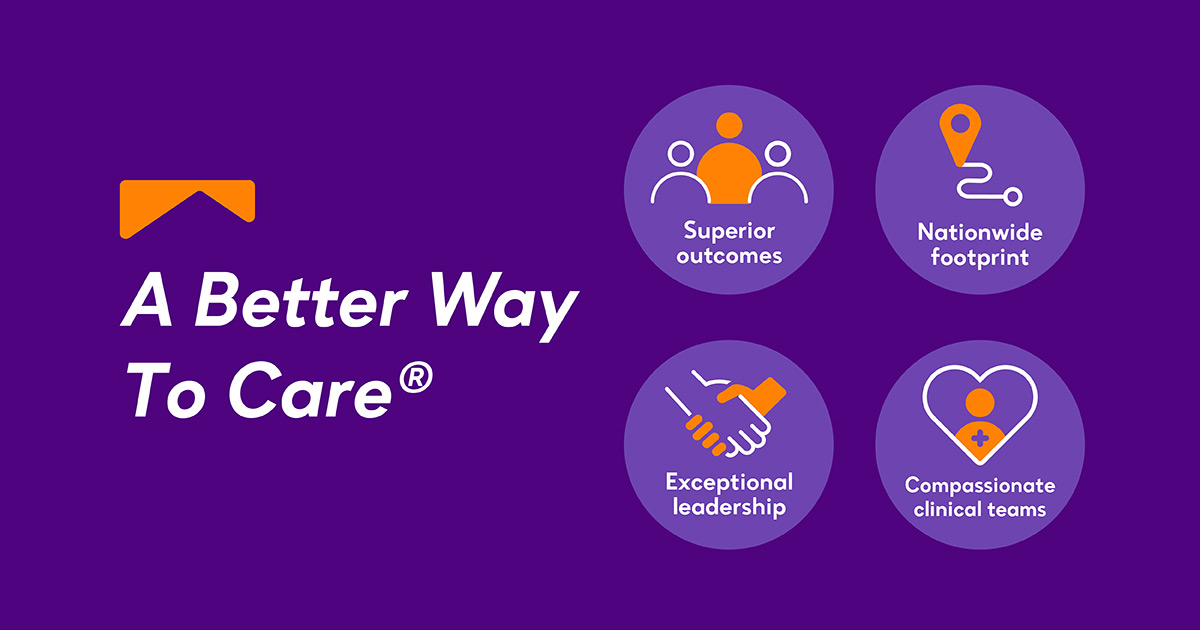Home health and hospice glossary
We recognize that many patients and families electing home health or hospice care for the first time may come across terminology that at first may seem unfamiliar. Use this guide as a resource to help understand potential terms you may encounter throughout your health care journey.
A
Activities of daily living (ADLs) – A series of basic activities necessary for independent living. They include bathing or showering, getting dressed, eating and going to the toilet.
Acute – Indicates sudden start of a severe medical condition.
Acute care – A level of care for treatment of relatively short-term needs, such as severe illness or recovery from surgery; usually at a hospital or urgent care facility.
Acute pain – Pain with a relatively sudden start and lasts a relatively short length of time.
Advance directive – A legal document that outlines the patient’s wishes about receiving medical care if they are unable to make those decisions themselves, usually because of injury or illness; laws governing advance directives vary by state.
Aggressive – When describing a disease, usually indicates a disease that is growing more quickly than expected; when describing a treatment, usually describes a treatment that is more intense than the standard.
Alzheimer’s disease – A type of dementia that affects memory, reasoning and behavior. Alzheimer’s is marked by progression from mild issues with cognition and memory to severe dementia, according to the nonprofit Alzheimer’s Association.
Ambulation – Walking; usually indicates walking without any mechanical or physical assistance.
Aphasia – A communication disorder characterized by lessened ability to process language — usually spoken language but sometimes written language as well; most often linked to a stroke, head injury, brain tumor or brain disease. Aphasia does not indicate loss of intelligence.
Aspiration – The breathing of a foreign object, such as food or liquids, into the lungs.
Assisted living facility (ALF) – These living facilities assist people who need different levels of medical and personal care in a home-like setting designed to promote a resident’s independence.
Attending physician – A physician who works with the medical director and the hospice team to ensure the care plan meets each patient’s needs.
B
Bereavement – The process of grieving a loved one’s death.
Blood pressure – The measure of the pressure of one’s blood against the walls of blood vessels as it pumps through the body.
C
Centers for Medicare & Medicaid Services (CMS) – The federal agency that oversees Medicare and Medicaid, including determinations of benefits.
Certified medical director (CMD) – This title indicates training that focuses on clinical issues and management of long-term care. A CMD must be certified by the American Board of Post-Acute and Long-Term Care Medicine (ABPLM).
Certified nursing assistant (CNA) – A CNA helps patients with activities of daily living and other health care needs under the direct supervision of a registered nurse (RN) or licensed nurse (LPN/LVN).
Chaplain – A certified clergy member who provides spiritual guidance and support to patients and their families as they navigate the hospice journey.
Chronic – A condition or illness that reoccurs or lasts over a long amount of time.
Chronic obstructive pulmonary disease (COPD) – A disease that affects the lungs’ ability to use oxygen and get rid of carbon dioxide, most commonly caused by smoking. Long-term irritation to the lungs and bronchial tissue are the main reasons people develop COPD.
Cognitive impairment – Used to describe negative changes in mental processes, such as the ability to use judgment, remember, learn or control moods; may be mild to severe. All dementia is cognitive impairment, but not all cognitive impairment is dementia.
Comfort care – Comfort care is similar to palliative care in that it focuses on symptom control, pain relief and quality of life.
Comorbidities – Additional medical conditions that are not the main reason for treatment.
Consumer Assessment of Healthcare Providers and Systems (CAHPS) – A standardized approach to gathering, analyzing and reporting information on consumers’ and patients’ experiences with health care services.
Continence – The ability to use and control the bladder and bowels.
Continuous home care – Crisis care that is usually provided in the home for hospice patients who need short-term management of severe symptoms. One of the four levels of care that must be included for a hospice program to be Medicare-certified.
Coronary artery disease (CAD) – Occurs when the inner walls of coronary arteries (which supply blood to your heart muscle) begin to form deposits or plaque. As the plaque grows, it can cause the coronary artery to narrow, which decreases blood flow to the heart muscle.
D
Dementia – An umbrella term that refers to decreased brain and cognitive function that may include memory disorder and impaired reasoning; causes and symptoms vary. In the United States, the most common cause of dementia is Alzheimer’s disease, followed by vascular dementia and Lewy body dementia.
Diabetes – Diabetes occurs when the pancreas cannot make enough insulin or the body is unable to use the insulin correctly. There are two types of diabetes: Type 1 and Type 2.
Discharge planning – Any interdisciplinary approach to ensuring continuity of care after discharge from a hospital or other acute care facility. Whether the process is formal or informal, discharge planners work to coordinate assessments, recovery goals, planning and implementation between hospitals, health care providers, community organizations and caregivers.
Durable medical equipment (DME) – Equipment that can be used repeatedly such as a wheelchair or walker.
Do not resuscitate (DNR) – DNR also known as a “no code.” Written by a doctor at the request of the patient, this medical order specifies that the patient does not want cardiopulmonary resuscitation (CPR); in its absence, medical personnel will use all means available for resuscitation. Because laws governing DNRs can vary from state to state, the order can include other extraordinary measures, such as resuscitation drugs or intubation.
Related acronyms for medical orders with similar scope include: allow natural death (AND); clinician’s orders for scope of treatment (COST); clinical orders for life-sustaining treatment (COLST); do not attempt resuscitation (DNAR); medical orders for scope of treatment (MOST); physician orders for life-sustaining treatment (POLST); physician orders for scope of treatment (POST); and transportable physician orders for patient preferences (TPOPP).
E
Electronic medical records (EMR) – An electronic version of a patient’s medical history, that is maintained by the provider over time.
G
General inpatient care (GIP) – Crisis care that is usually provided outside the home in a hospital or skilled nursing facility (SNF) for hospice patients who need short-term management of severe symptoms. One of the four levels of care that must be included for a hospice program to be Medicare-certified.
H
Heart disease – An umbrella term for many different cardiovascular conditions and is used in a general way to describe problems with the heart. The most common type of heart disease is coronary artery disease (CAD).
Heart failure – Occurs when the heart stops pumping a sufficient amount of blood and oxygen to support other organs in the body. It does not indicate that the heart has stopped beating but it does mean that it’s not working as well as it should.
Holistic care – Takes all personal factors into account when creating a treatment plan as opposed to just focusing on the medical factors. This includes social, psychological, emotional and physical.
Home and community-based services (HCBS) – Provide opportunities for Medicaid beneficiaries to receive services in their home rather than moving to a facility for care.
Home health agency (HHA) – Agency or organization that delivers skilled care in a patient’s personal residence. Associations that accredit home health agencies include the Accreditation Commission for Health Care, Community Health Accreditation Program and Joint Commission on Accreditation of Home Healthcare Organizations.
Homebound – A person who is unable to leave home without great difficulty, including patients who need the help of another person, a cane, a walker or a wheelchair. Under Medicare coverage, a person must be certified as homebound by a physician to qualify for home health services.
Home health aide – Someone who assists or provides the patient with personal care services such as bathing, dressing, feeding and going to the toilet.
Home health care – A term that encompasses a range of professional medical services, including skilled nursing care, as well as other skilled care services, such as physical and occupational therapy, speech-language therapy and medical social services. These services are provided by skilled health care professionals in the home.
Hospice – A program focused on end-of-life care for patients who have decided to stop aggressive treatment for their disease; hospice care focuses on providing comfort care, reducing pain and maintaining the best possible quality of life for patients and their families.
In hospice, patients usually have a life expectancy of six months or less if their disease follows its normal progression. The hospice team provides physical, spiritual and emotional support, including support for family caregivers. Levels of care will vary according to patient and caregiver needs, and most patients will need more than one level of care during their time in hospice. A hospice benefit (MHB) is included in Medicare coverage. For a hospice agency to be Medicare-certified, it must offer four levels of care: routine home care, general in-patient care, continuous home care and respite care.
Hospice aide – A certified and trained hospice professional who assists patients with activities of daily living and provides emotional support and comfort measures.
Hospice benefit – The Medicare hospice benefit covers care for you or your loved one’s terminal illness and related conditions. The Medicare program covers hospice care for two 90-day and unlimited 60-day periods, if no revocations or discharges occur. There is no copay or out-of-pocket cost for qualified Medicare beneficiaries.
Hospice volunteer – Provides respite time and non-medical services for caregivers while offering companionship for patients and their loved ones.
Hypertension — Also known as high blood pressure, hypertension is when the pressure of blood flow is too high, causing the heart to work harder.
Hypotension —Low blood pressure as determined by a doctor; usually when the systolic (top number) is lower than 90.
I
Incontinence – The inability to control the bladder and bowels.
Inflammation – Occurs when the body’s immune response is triggered to help fight off infection or heal damaged tissue. This is how the body normally responds to an injury or infection of any kind.
Influenza – Commonly called the flu, influenza is a respiratory illness that affects the nose, lungs and throat. It is highly contagious and both types (A and B) are routinely spread.
Inpatient – A setting where a patient stays overnight at the hospital or facility while receiving treatment and recovering.
Inpatient rehabilitation facility (IRF) – IRFs treat patients who require hospital-level care in conjunction with intensive rehabilitation.
Inpatient respite – A level of hospice care that means short-term care is provided at an inpatient facility and the patient receives all of their care outside of the home. This gives the family members or friends a break in their caregiving duties.
Interdisciplinary team (IDT) – A group of experts from various disciplines working together to treat an ailment, injury or chronic health condition.
J
Joint replacement – Replaces parts of the arthritic or damaged joint with a prosthetic device. First performed in the late 1960s, there have been many improvements to surgical techniques over the years, such as the discovery of minimally invasive approaches. The use of different materials, like ceramics, titanium and plastics, is also constantly improving patient outcomes and satisfaction, and helps replacement parts last longer.
L
Length of stay – The time a patient stays in a care setting.
Licensed nurse (LPN/LVN) – Typically, a licensed nurse manages tasks such as: administration of medication; changing wound dressings; administration of tests, such as blood pressure or temperature checks. An LPN/LVN must complete a year of training and pass a licensing exam.
Low vision – Low vision is the result of vision loss that limits you from doing everyday activities safely. Although it doesn’t mean you are legally blind, it means that your vision sharpness cannot be restored with glasses, surgery or medication.
M
Mild cognitive impairment (MCI) – Used to describe an early stage of memory loss or other cognitive loss like language.
Medical durable power of attorney (MDPOA) – A directive naming someone who has the authority to make medical decisions for the patient if the patient is unable to speak for themselves due to an illness or injury.
Medical director – In hospice, a medical director is a physician who works closely with each patient’s physician and care team to create the best plan of care.
Medical social worker – A medical professional who evaluates the emotional and social needs of patients and their loved ones in order to connect them with short-term counseling and community services.
Medicare – The federal health insurance program for adults over the age of 65; certain people with disabilities or end-stage renal disease may also use Medicare.
Medicare Advantage – A Medicare plan that is offered by private companies. Medicare pays these private companies to cover your Medicare Part A and Part B benefits.
Medicaid – The federal health insurance program for eligible low-income adults, children, pregnant women, elderly adults and people with disabilities.
O
Occupational therapist – A health care professional focused on improving the fine motor skills and physical strength of patients so they can manage tasks related to activities of daily living.
Occupational therapy – A form of therapy for those recuperating from physical or mental illness that encourages rehabilitation through the performance of activities of daily living (ADL).
Oncology – A specific field of health care that specializes in the diagnosis and treatment of cancer.
Orthostatic hypotension – Also known as postural hypotension; when blood pressure drops suddenly because the patient goes from lying down to an upright posture or from sitting to standing.
Outcome and Assessment Information Set (OASIS) – Standardized data specifications that make it possible to compare patient outcomes in home health care.
Outpatient – When a patient receives treatment at a facility but is not admitted overnight.
P
Palliative care – Often referred to as “comfort care;” emphasizes quality of life and mitigation of suffering but may also include treatment of disease. Learn how palliative care is different than hospice care.
Parkinson’s disease (PD) – A neurological disorder that is estimated to affect about 2% of adults over the age of 65. The Parkinson’s Foundation, a nonprofit that provides information and support on the condition, estimates that nearly 1 million Americans are currently affected and that the number will increase during the next decade.
Patient experience – Refers to the range and summary of interactions that patients have with different parts of health care systems.
Primary care physician (PCP)–Refers to the doctor you see regularly for check-ups. They work closely with home health and hospice teams to create a plan of care specific to each patient’s needs.
Plan of care (POC) – A written plan describing the type and frequency of health services a patient needs.
PRN – PRN is a medical abbreviation that means “as needed.” In health care, PRN refers either to the frequency a medication should be taken, or to a nurse or other clinician filling in for staffing gaps.
Prognosis – The likely course or progression of a disease or condition.
Premorbid – Occurring or existing before the start of a disease or illness.
Post-acute care – A setting in which patients receive care after or in lieu of an acute care stay, such as inpatient rehabilitation hospitals, home health and skilled nursing facilities (SNF).
Physical therapist – Trained professionals who work with patients to improve mobility, adjust to adaptive equipment and improve balance.
Physical therapy (PT) – PT is part of an interdisciplinary home health care team that helps individuals resume daily activities and improve overall health and wellbeing.
R
Readmission – When a patient returns to the hospital within 30 days of a prior stay.
Referral – When a doctor sends a patient to another doctor to receive specialized care. Patients must receive a referral from their physician before receiving home health or hospice services.
Rehabilitation – The process of treating someone’s illness or condition so that they can get back to living their normal life. Rehabilitation centers are facilities patients visits to receive therapy or training; there are also inpatient rehabilitation centers where patients stay overnight to receive care.
Registered nurse (RN) – Education and licensing requirements vary by state, requiring either an Associate of Science in Nursing degree (ASN) or a Bachelor of Science in Nursing degree (BSN), in addition to passing a licensing exam.
Remote patient monitoring (RPM) – Refers to any of several systems of technology that allow a clinician to monitor a patient outside the office or hospital.
Respite care – Temporary care usually provided to a hospice patient in a skilled nursing facility (SNF), in-patient hospice facility or hospital so that a family or similar home caregiver can take time off; determined by the needs of the caregiver and not the patient. One of the four levels of care that must be included for a hospice program to be Medicare-certified.
Routine home care – The most common level of hospice care, in which the patient is stable and their symptoms can be controlled; usually takes place in the home. One of the four levels of care that must be included for a hospice program to be Medicare-certified.
RSV – Respiratory syncytial virus (RSV) is a common virus that infects the lungs and can cause mild, cold-like symptoms. RSV can also progress to bronchiolitis or pneumonia in high-risk patients.
S
Skilled nursing – Skilled nursing care refers to a patients need for care or treatment that can only be performed by licensed nurses.
Skilled nursing facility (SNF) – An inpatient facility that provides 24/7 nursing care. The goal of these facilities is to help patients recover, many times after a hospital stay, so they can return home.
Speech language pathologist (SLP) – SLPs are experts in oral and motor cognition that can improve swallowing, mental processing and language skills.
Speech therapy – Speech therapy services improve patient’s language skills, mental processing and swallowing to facilitate independence.
Start of care (SOC) – An initial, comprehensive assessment that is required before a patient begins care at a home health agency; used to gather data about the patient’s physical, functional, mental, psychosocial and cognitive status to meet the patient’s individual needs and form the plan of care.
Stroke – A stroke occurs when a blood vessel is no longer able to carry nutrients and oxygen to the brain. This can be caused by a thick clump of blood (a clot) or a burst in the vessel (a rupture). When this happens, the affected part of the brain cannot get the blood and oxygen it needs. This causes the brain cells and tissue to begin to die.
T
Telehealth – Sometimes called telemedicine, telehealth allows your physician to provide care without a visit to their office. This is done by use of a personal computer or smart phone and connection to the internet.
Transfers – Movement of a patient from one place to another. Depending on context, may refer to movement from a bed to a wheelchair, relocation from one ward to another or from one facility to another.
Transitional care – When someone needs to transition their health care services from one setting to another. An example includes transitioning back home from the hospital or transitioning from home health to hospice care.
Traumatic brain injury (TBI)– Is an injury that affects how the brain works, usually as a result of sudden trauma to the brain.
Type 1 and Type 2 diabetes – Type 1 diabetes is the result of the pancreas not making enough insulin or none at all. Type 2 is the most common type of diabetes where the body is able to produce insulin at first but is no longer able to make enough, produce any insulin, or has become resistant to using insulin correctly.
W
Wound care – Treatment for wounds such as pressure ulcers, lower extremity ulcers, surgical wounds and burns.
V
Vascular dementia – Dementia caused by interrupted blood flow to the brain, which may happen from a stroke or series of strokes.
Vestibular system – This system is what helps us keep our balance when walking or changing surfaces. It works with the joints and muscles in our spine to make small changes in our posture that helps us stay balanced. When all parts of the system aren’t working well, it can cause dizziness, imbalance, hearing problems and nausea.
Z
Zone tools – A tool that allows patients to self-evaluate according to a system of guidelines and checkpoints covering conditions ranging from diabetes to pain management. Patients and/or caregivers are provided with a factsheet that contains checklists divided into three zones: Green, Yellow and Red.
For example, if a patient can check all the actions in the Green Zone, then they are “all clear,” and the symptoms are judged to be under control. If they are experiencing symptoms in the Yellow Zone, then they are advised to proceed with “caution,” and are advised how to “act now.” The Red Zone represents an emergency, listing situations when patients should call 911 or go directly to the nearest emergency room.
Social Share
At Enhabit, our patients are our number-one priority. From delivering high-quality, evidenced-based practices to building deep, personal connections, we’re focused on upholding every patient’s dignity, humanity and sense of control during their health care journey.
Home health
Our home health services give patients access to the care they deserve in the comfort of their own homes. From disease and injury management to recovery from surgery, our clinicians help patients confidently achieve their health care goals.
Hospice care
Our hospice services place importance on the comfort of every patient living with a terminal illness. Our team of caring professionals is dedicated to providing not just physical care, but spiritual and emotional support to every patient and their loved ones throughout the end-of-life transition.






